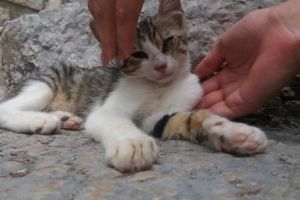Caring for outdoor and feral cats during the winter months can make a world of difference in their lives. Many of these cats, whether lost, abandoned, or part of a feral cat colony, have learned to survive on their own. But when temperatures drop, even the most resourceful outdoor cats need extra help to stay safe and warm. Providing food, shelter, and a little care can go a long way in protecting these animals from the dangers of winter.
Whether they’ve found a place in your yard or neighborhood — or in your heart — caring for them during the cold weather months is a simple act of kindness that can significantly improve their well-being. As veterinarians, we commend your compassion and are here to help you ensure these cats stay safe through the harshest months of the year.
Cats and Cold Weather
While cats are known for their resilience, cold weather can be particularly challenging for both outdoor cats and feral cats. Despite their thick fur, cats are not immune to the harsh effects of cold temperatures. In general, cats can handle mild cold weather, but as temperatures start to dip below freezing (32°F or 0°C), things become dangerous, especially for those without consistent shelter. 
Outdoor cats in winter will instinctively seek out warm places to shield themselves from the elements. You might find them under cars, in garages, or huddling near buildings for warmth – and on cold days it’s always a good idea to check under vehicles for cats seeking shelter before turning them on or moving them! However, prolonged exposure to freezing temperatures can lead to serious health issues like frostbite and hypothermia. Cats are most susceptible to frostbite on their ears, paws, and tails, which have less fur and are more exposed to the cold.
A good rule of thumb is: if it's too cold for you, it's likely too cold for your cat. Temperatures below 45°F (7°C) can already start to cause discomfort, and any prolonged exposure below 32°F can be life-threatening. Cats and cold weather don’t mix well when temperatures plummet, so it’s essential to provide a warm, insulated space where they can escape the cold.
If you’re wondering how to keep feral cats warm in winter, offering safe shelter and checking on them regularly is key. Watch for signs of hypothermia, such as shivering, lethargy, or a cat that seems disoriented. If you notice these signs, take action immediately by getting them indoors or contacting local animal services for help.
What You Need to Understand About Feral Cats Vs. Neighborhood Cats
Neighborhood cats, which can sometimes include outdoor cats in winter, may be fearful of humans but are still somewhat domesticated. Be cautious—go slow, and with time, they may start to seek affection. These cats may have had a home previously and could require more help getting through the winter than feral cats that are more accustomed to fending for themselves.
On the other hand, feral cats are not domesticated and are extremely fearful of people. They will often run if approached, and if they feel threatened, they may hiss, scratch, or bite. These cats are much less likely to warm up to human interaction, and it could take years for them to feel comfortable enough to be touched.
How to Determine If a Cat Has a Home
Now that you understand the hazards of cold weather for outdoor cats, you'll want to take some steps to determine if the cat(s) that come to visit you have a home or live outside full time as strays or feral cats. You can try asking neighbors if they recognize the cat(s) or know any history. You can also check with the local animal shelter to see if they can scan for a microchip or if you need to bring them in. Some shelters may even offer resources to help with spaying/neutering or vaccinations, especially if the cat doesn't seem to have an owner.
If the cat doesn’t have a home and you want to provide a safe space for cats during cold weather, they will need the basics — food and shelter.
How to Keep Feral Cats Fed in Winter: Food and Water
Feeding feral cats during winter requires some care. If you leave food out all the time, you may attract wildlife, which can be dangerous for both you and the cat. Put food out when the cat is around and remove it when they leave. If you're busy, leave food out during the day and take it away at night when wildlife is more active. Wildlife can transmit diseases like rabies, parasites, or even injure the outdoor cats you're trying to help. Don't forget to provide water as well, ensuring it doesn’t freeze in the cold.
How to Keep Feral Cats Warm in Winter: Providing Shelter
The cat will naturally seek shelter wher e they feel safe from the elements. Creating a shelter for outdoor cats in winter is key to ensuring they survive the cold. There are many tutorials available for making simple outdoor shelters using items like coolers or plastic totes, lined with styrofoam or old blankets. Place the shelter in a low-traffic area away from people and pets, and position the entrance away from the wind.
e they feel safe from the elements. Creating a shelter for outdoor cats in winter is key to ensuring they survive the cold. There are many tutorials available for making simple outdoor shelters using items like coolers or plastic totes, lined with styrofoam or old blankets. Place the shelter in a low-traffic area away from people and pets, and position the entrance away from the wind.
To encourage the cat to enter, place food near the entrance and gradually move it further inside. If they don’t take to the shelter immediately, don’t give up. Try adding more shelters with varying materials — some with blankets, others with straw or wood shavings. Over time, especially as temperatures drop, the cat will likely seek out the warmth provided.
Relocating Feral Cats in Extreme Cold
If the cat refuses to use the shelter and the cold weather becomes too extreme, you may need to consider relocation. Trapping the cat and working with an animal organization or shelter can provide temporary safety, and this may also be an opportunity to get them spayed or neutered if needed.
If relocation isn’t feasible, another option is to keep the cat in a garage or spare room. However, be cautious as feral cats may harm themselves in attempts to escape. In such cases, it might be best to let them remain outside with access to shelter.
Feral Cats and Affection (Or Lack Thereof!)
You might have heard stories of people "taming" feral cats and bringing them indoors. While this does happen, it’s more the exception than the rule. Feral cats generally don’t like being touched or picked up. Let them come to you in their own time. Though you may not end up petting them, simply providing food and shelter greatly improves their chances of surviving cold weather.
Resources for Feral Cats and Outdoor Cats in Winter
Helping outdoor cats in winter can be a fulfilling but challenging endeavor. Here are some great resources for learning more about how to assist these cats during cold weather:
- Alley Cat Allies
- AVMA Free-Roaming Cats Policy
- American Association of Feline Practitioners
- Cat Friendly Homes
If you have questions about how to help feral cats, or you want to find out if a neighborhood cat is microchipped connect with your veterinarian.
Don't have a vet in your area yet? We can help you find a local veterinarian.
If you have more questions, the GeniusVets Teletriage platform will give you unlimited access to text and/or video calls with board-certified veterinarians! To learn more click here.


The Ultimate Guide
to Cat Care
This free guide is an indispensable manual for cat ownership. Filled with veterinary advice and recommendations on every important topic at each stage of your cat's life, this is all the stuff that responsible cat owners need to know. That is why we are making it free!
